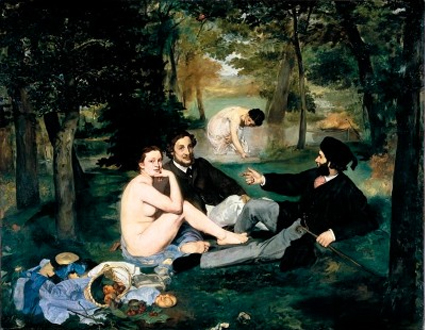With the longest day of the year fast approaching, and the picnic season at its height, this week’s picture is Edouard Manet’s Le Dejeuner sur l’Herbe. It can be seen (perhaps after a picnic in the Jardins du Luxembourg) at the Musee d’Orsay in Paris.
Manet submitted this monumental but disconcerting image of four Parisians in a woodland glade to the 1863 Salon, the principal annual public art exhibition in Paris. It was rejected by an unusually severe jury. To appease the nearly three thousand artists who like Manet had been excluded from the exhibition, the French government and art establishment offered them the olive branch of their own separate show in the Palais des Champs-Elysees. The “Salon des Refuses” was seen as a counterblast against the official Salon and the traditions for which it stood. The picture which seemed most perfectly to epitomise its rebellious and self-consciously modern spirit was Manet’s Dejeuner sur l’Herbe.
The work was reportedly inspired by the sight of people picnicking and bathing by the side of the Seine in the village of Argenteuil, a suburb of Paris. Manet knew the people in his picture. The seated men are portraits of his brother and brother-in-law, while the nude is his model, Victorine Meurent. The painter was influenced by Charles Baudelaire’s call for “a painting of modern life”, an art which would seize on and immortalise the peculiar characteristics of mid-nineteenth-century existence, such as the hats, coats and boots of contemporary male fashion. In choosing the theme of a picnic, the artist was homing in on a conspicuous trend, the growing fondness among the city-dwellers of the nineteenth century for interludes of rural escape. But the Dejeuner sur l’Herbe is hardly a simple exercise in social observation. Naked women were not seen in public,...


